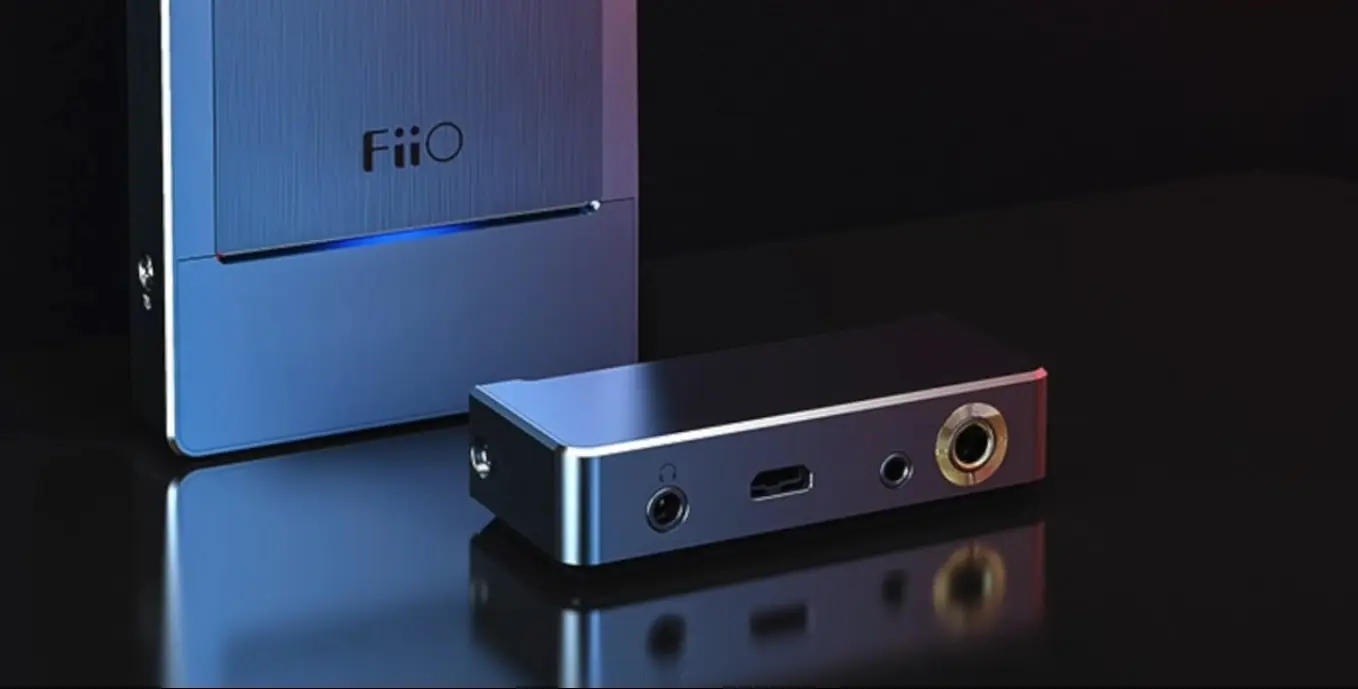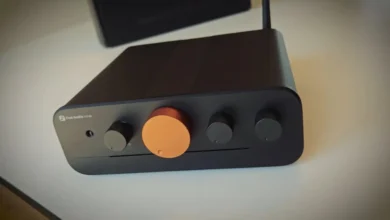
In light of the midsummer weather that has been going on for a few weeks now, I have decided to introduce you to a few selected mobile highlights in the headphone sector, which, IMO stand out from the now almost unmanageable mass of portable HIFI dwarfs.
After all, you want to be able to indulge in your beloved headphone hobby without any problems, even in sweaty temperatures. If possible, of course, while maintaining adequate sound quality while remaining as easy to use as possible. And, of course, price also plays a certain, if not often the decisive, role.
Read Also: Dragonfly Red vs Black: Audiophile Showdown
Starting today is the new Q5 DAC and headphone amplifier from FIIO. This Chinese bonsai boasts an astonishing array of features, yet is by no means overly user-friendly. As always, many thanks to Markus Nagler from FIIO’s German sales department for promptly providing my review unit.
Processing & Equipment
As expected, the FIIO Q5 is of high quality and very carefully crafted. The individual controls appear organically integrated, are precisely embedded in the Q5’s finely brushed all-aluminum housing, and are also clearly labeled for their functions.
On the input side, the Q5 features two separate micro-USB ports, with the left-hand one serving as a dedicated charging port. This allows the device to be charged simultaneously when used as a pure USB DAC.
According to FIIO, the consistent separation of the power supplies of all sound-relevant components also ensures a clean and interference-free transmission of all musical information.
Furthermore, the FIIO offers a 3.5 mm jack socket on the top of the Q5, which can be used either as an analog line input or as an optical or coaxial digital connection.
The line output, also in 3.5 mm format, is located nearby and operates with an output voltage of 2 V and, if required, makes appropriate contact with stationary equipment as a preamplifier.
All types of earphones connect to the bottom of the Chinese headphone amplifier via an interchangeable amplifier module, either symmetrically (2.5 mm TRRS) or asymmetrically (3.5 mm). A selector switch allows Q5’s output level to be adjusted accordingly in two stages.
The AM3A module is included as standard, which can be “maximized” to a maximum output of 2 x 80 mW at 32 ohms in balanced operation. Therefore, high-efficiency headphones are recommended.
You May Like: Chord Mojo 2 Review:
However, FIIO deserves credit for including the above power rating with a corresponding load resistance. This isn’t always a given, especially with mobile devices. No one can make sense of specifications like “2.0 Vrms (condition no load).”
Especially since in physics, power is still measured in watts and not in volts.
A 3,800 mAh lithium polymer battery provides the necessary power even for long-lasting acoustic escapades. The FIIO Q5 can play for up to 10 hours in full musical mode without power interruption; this already impressive performance doubles when used purely analogically.
A slide switch for the now obligatory bass boost is a must for a mobile device made in Asia and completes the Q5’s well-thought-out features. However, from an audiophile perspective, this control is, in my opinion, simply superfluous. Well, as always, it’s a matter of taste.
Of course, the elegant matte black box also contains all sorts of useful accessories, which, as always, are quite extensive, as is typical of the brand. A padded black carrying case is included, as are connectable cable sets and various rubber bands for attaching potential playmates.
The Chinese manufacturer even included a truly high-quality screwdriver for replacing the amplifier modules. Truly commendable.
Technology
In particular, the comprehensive Bluetooth equipment ultimately prompted me to take a detailed acoustic look at the Q5 and include it in my “Summer Special” collection.
FIIO has equipped its latest headphone amplifier with a cutting-edge and innovative Bluetooth 4.2 APTX chipset, which is capable of decoding even high-resolution 24-bit data sets without any problems.
The data received by the Bluetooth chipset is also forwarded directly to the Q5’s top-of-the-line AK4490 DAC, thus consistently bypassing the Bluetooth receiver’s internal converter.
The state-of-the-art Bluetooth chip can be updated via a USB connection, making it future-proof. The Bluetooth function can be easily enabled/disabled, and pairing, for example, with a smartphone, is very smooth and, above all, extremely reliable.
Interestingly, the small DAC headphone amplifier also allows rudimentary direct access to the music program in wireless mode via three manual push buttons on the left side of the silver aluminum casing. These buttons can be used to skip tracks in both directions, as well as pause and resume playback. The corresponding control commands are transmitted almost instantly to the Bluetooth-paired device.
This, combined with the integrated rotary knob for finely adjustable volume control on the right side of the FIIO Q5, results in simple yet optimal operation from a single device. My phone can therefore stay in my pocket while an album is playing. Great.
Preparation
As an adequate price partner for the FIIO, I chose the AUDEZE ISINE 20, which I will use to test the sound of the Q5 in both connection versions.
In the first test setup, I connect my iPhone X via an AUDIOQUEST CINNAMON digital cable, which establishes direct cable contact with the FIIO Q5. In the second step, the music data is streamed via the Chinese dwarf’s Bluetooth receiver, thereby detecting any sonic differences compared to the wired version. In a third step, I test the FIIO Q5’s preamplifier qualities on FELIKS’s sonic high-flyer, the ECHO, thus leaving the Q5’s amplifier section out of the equation.
The musical fare consists of the usual suspects from classical, rock, pop, blues and jazz, which can be played back on the IPHONE X uncompressed but at most in CD quality.
However, a quick cross-check on my APPLE IMAC with optimized AUDIRVANA+ software, on which I therefore operate the FIIO Q5 as a pure DAC, reveals no significant sound differences with higher resolution HIGH-RES data material.
As usual, you can find further information about the FIIO Q5 via the all-knowing search engines on the Internet or the manufacturer’s website at: fiio
Sound test
Well, to cut a long story short, In a direct comparison with the USB connection, I can’t detect any significant sound differences between my acoustic treasures and Bluetooth-based reproduction via the iPhone X.
The FIIO Q5’s soundstage is excellent in both cases, and even individual musical elements are always well separated. Like most mobile devices, the Q5’s depth is a bit flat, but overall, the depth is still completely satisfactory.
With exquisitely produced tracks, the spatial boundaries may be illuminated a little more precisely with a wired connection. However, this is only noticeable in close comparison and certainly doesn’t play a major role, especially in mobile use. The overall sound quality via Bluetooth 4.2 APTX is already record-breaking in this product segment and, in my opinion, currently unmatched.
Especially in combination with the FIIO’s sonically outstanding and channel-separated AKM converter section, the Q5 is characterized in both operating variants by a neutrally balanced yet dynamic playing style, which fortunately also avoids any harshness.
Transients are reproduced naturally, while sibilants are slightly smoothed – the sound always appears pleasantly relaxed, with the slight midrange preference typical of the AK4490 chipset. This results in a very transparent reproduction in this frequency spectrum.
The FIIO Q5 also resolves high tones precisely and meticulously, although it does not quite reach the level of stationary devices, which may have identical converter components but usually have more complex analog output stages.
Furthermore, the bass range is very well structured and always delivers sufficient punch, although the depth naturally doesn’t reach the ultimate levels for this type of device. The same applies to the dynamic reserves at higher volumes, especially when driving power-hungry, magnetostatic headphones.
The AUDEZE ISINE20, on the other hand, proves to be an almost ideal partner for the FIIO Q5 and, thanks to its remarkably good efficiency, can be used even at excessive levels without any compression effects.
Symmetrical operation is preferable. The contours in the bass range are instantly sharpened, vocals and instruments are more clearly focused, and the room expands in width and depth. In particular, tonal nuances are rendered even more sensitively.
The combination with the FELIKS ECHO reveals the high sound quality of the Bluetooth/DAC section of the FIIO and therefore expressly recommends the Q5 for stationary use at home.
Conclusion
The FIIO Q5’s sound quality is impressive, making it suitable for even the most demanding audiophile. A carefully selected partner is a must, however.
The unique Bluetooth sound quality also predestines the small Chinese ingenuity for mobile applications of all kinds and, IMO, also serves as a future benchmark for potential competitors in this segment.
But the FIIO also excels as a veritable preamplifier. Especially since the Q5 in this version provides a sufficiently high output level and the Chinese manufacturer has paid the utmost attention to the first-class AKM converter section.
Due to the relatively affordable retail price of €419, I not only have to attest to the FIIO Q5’s excellent price-performance ratio, but I also give it an unconditional purchase recommendation.
It’s worth trying out.
Pros And Cons of FIIO Q5
Pros:
✔ Dual DAC Setup – AKM AK4490EQ (balanced) + AKM AK4462 (single-ended) for clean, detailed sound
✔ Modular Design – Swappable amp modules (AM3A/AM3D/AM3E) for balanced or high-power output
✔ Bluetooth 4.2 (LDAC/AptX HD) – Wireless hi-res audio support
✔ High Power Output – Up to 800mW @ 32Ω (balanced), drives demanding headphones
✔ Versatile Inputs/Outputs – USB, optical, coaxial, 2.5mm/3.5mm/4.4mm outputs
Cons:
✖ Bulky for Portable Use – Larger than most dongle DACs (142g)
✖ No Bluetooth 5.0 – Older 4.2 limits wireless range
✖ Battery Life (~10hrs) – Shorter than newer competitors
✖ No MQA Support – Lacks full decoding for Tidal Masters
Specifications FIIO Q5
| Category | Details |
|---|---|
| DAC Chip | AKM AK4490EQ (Balanced) + AK4462 (SE) |
| Amp Module | AM3A (default), upgradable to AM3D/AM3E |
| Output Power | 800mW @ 32Ω (Balanced), 220mW @ 32Ω (SE) |
| Bluetooth | 4.2 (LDAC, AptX HD, AAC, SBC) |
| Inputs | USB-C, Optical, Coaxial, Bluetooth |
| Outputs | 3.5mm (SE), 2.5mm/4.4mm (Balanced) |
| Battery | 3,800mAh (~10hrs playback) |
| Weight | 142g |
| Price | $299 (Discontinued, replaced by Q5s TC) |
🎯 Best For:
- Audiophiles needing balanced output on the go
- Desktop/Portable Hybrid use with swappable amps
- Legacy Bluetooth users (LDAC/AptX HD is still great)
Alternatives:
➜ Q5s TC (Bluetooth 5.0, THX amp)
➜ iFi Gryphon (MQA, newer Bluetooth)



